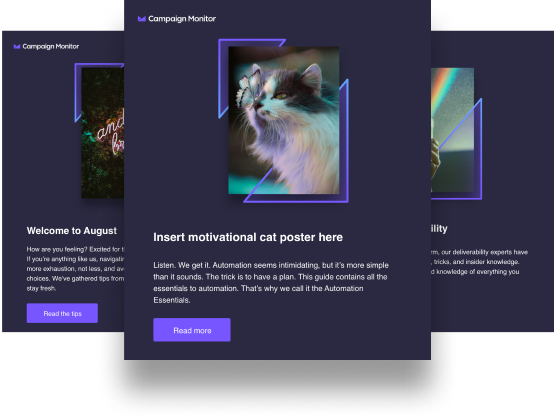With the arrival of a new season it got us thinking about email marketing programs like gardens. Some are tidy and vibrant, filled with blossoming flowers, while others are in need of some TLC. And, just like a garden requires year-round maintenance, so too does your email marketing efforts. Full landscaping isn’t always necessary, however regular pruning can breathe new life into your campaigns, making way for “new buds” and green shoots, which can ultimately help you reach your desired goals.
In this edition, our Compliance experts share their top tips on maintaining balance and harmony in your email marketing ecosystem.
Encourage new growth
It’s always a good idea to give new subscribers an introduction to their new subscription. An effective way to do this is by creating an automated welcome journey. A welcome journey provides a timely and relevant opportunity to introduce your brand, set expectations around the content and communications you will send, while also making the right first impression with new subscribers and ensures:
- You set further expectations around email send frequency
- Provide insight into when and how their data will be used
- You identify truly engaged subscribers and those who are more transient.
For example, if you have a three-part welcome journey, you can easily identify subscribers who opened the first email, but ignored the latter two via subscriber segments.
To create such a segment, you can use rules like:
- Journey email #1 was not opened
~OR~ - Journey email #2 was not opened AND journey email #3 was not opened.
This segment categorizes subscribers who either didn’t open the first email (people who don’t open their welcome email may be safely considered uninterested), along with anyone who did open the first email, but ignored the latter 2.
This is particularly useful in situations where newsletter subscriptions are connected with another action – like making a purchase or creating an account to use a free service.
A welcome journey can also be leveraged to identify and target less attentive subscribers. Depending on how or if they interacted with your journey, you can target unengaged subscribers with a re-engagement campaign and confirm if they’d like to continue to receive your emails (this can be built directly into your welcome journey). These subscribers might respond better to an exclusive offer, or even a simple email to stay in touch – more on re-engagement tactics below.
Did you know that Campaign Monitor’s pre-built welcome journey streamlines the welcome journey set-up process and saves you set-up time? In a few simple clicks you can trigger a welcome journey – all you need to do is review, refine and turn it on.
Nurse your program back to health
Not every neglected plant should be pulled from its roots and disregarded. Some may just need a little light, water and attention. Your subscribers are the same. They may have engaged in emails relevant to their needs and missed the last few you sent, or simply taken a break from email. As mentioned above, a good way to check to see if they’re still interested in your brand is to send a re-engagement campaign. Best practice is to target those who last opened an email 6-12 months ago.
To re-confirm your subscribers’ permission, you could send a one-off campaign with simple call-to-action buttons. One for "Yes" and one for "No." The "Yes" button should direct to a confirmation page or a landing page on your website, while the "No" button should take them to an unsubscribe confirmation page (simply add the tag [unsubscribe] to the link).
Keep in mind that a re-engagement campaign to your less active subscribers is better to be spread across a couple of sends, rather than one large one, depending on how many people in your list you’re targeting. A large volume of sends to unengaged subscribers in one go could potentially harm your sender reputation, so if they account for a sizable portion of your audience, we recommend sending your re-engagement in smaller batches. To help you get started here are some useful examples of re-engagement campaigns you can send.
After a set time period, it’s best to segment those who didn’t click or open, and remove them by simply copying and pasting those contacts into Campaign Monitor’s deletion tool.
Additionally, to retain your subscribers’ interest, you need to ensure you’re emailing them with relevant and personalized content. It’s important to strike a balance of sending them enough content to remain engaged, but not so much that they become overwhelmed with email fatigue (just like watering your garden). The world of email marketing can be sensitive, but if you achieve the right balance, it’s more than worth the effort.
To help you target the right subscribers, we’ve released an Engagement Segments* feature. This intuitive tool automatically categorizes your subscribers’ into six pre-built segments based on their level of interaction with your emails, making it easier to monitor engagement, and send timely, personalized content – such as re-engagement campaigns or exclusive offers and content to reward your most active and engaged subscribers.
It’s best to focus on those who are most active with your email marketing program to ensure your deliverability and engagement metrics aren’t impacted.
Clean-up old leaves and make fresh ground
If it’s been a year or more since you last reached out to your subscribers, or if some recipients have stopped engaging with your emails, they’re likely too outdated to re-engage, so it’s best to weed them out entirely.
An easy way to exclude these subscribers is to add them to your suppression list. This ensures you avoid accidentally re-importing them in future. Don’t worry – the suppression list will still allow your subscribers to re-subscribe, if they want to rejoin your lists.
Once a subscriber or list has been identified as inactive, we recommend NOT repeatedly email them as it can:
- Increase the risk of spam complaints
- Lead to higher bounce rates from old, unengaged or abandoned addresses that no longer accept mail.
- Impact your sender reputation, and reduce deliverability to engaged subscribers
These are worst-case consequences for senders reaching out to old lists and can seriously impact your ability to reach future subscribers. Not only can sending to those unsuspecting recipients harm your brand, but you could also inadvertently violate anti-spam laws and policies, leading to spam complaints as well as blocklistings and suspensions (if the issue is significant). The older a list is, the more likely it contains Spamtraps (which can cause blocklistings). It pays to keep your email practices pruned and preened all year long.
Roundup and compliance top tips
Here’s a recap of what we covered, along with some useful best practice tips:
Send to your own permission-based and opted-in subscribers. Never purchase or rent email lists.
If you commit to respecting privacy by avoiding having your sends fall into any sort of unwelcome category, you’ll build stronger, more loyal relationships with your subscribers. At the same time, you’ll make the right impression with new subscribers.
It doesn’t have to be goodbye!
Re-engage your inactive subscribers with targeted campaigns before removing them. Leverage Campaign Monitor by Marigold’s intuitive Engagement Segments* feature to do the hard work for you by automatically categorizing and targeting inactives, and then remove them from your list altogether.
Make sure your subscribers want to receive your email
Leverage the confirmed opt-in to guarantee your subscribers’ permission and interest. This process ensures that subscribers are entering the correct email address, leading to cleaner and more accurate lists, which will help reduce bounce rates.
Make it easy for subscribers to update their preferences using Campaign Monitor’s Preference Center
If you send campaigns with regular frequency (such as daily, weekly or monthly) you can give your subscribers more flexibility and options to opt-down – rather than out, by allowing them to customize how often they receive your emails. This can be done by leveraging a custom field in the preference center and segmenting your sends to group subscribers based on these preferences.
This is just one of many ways to use custom fields, segments, and subscriber preferences to make sends feel tailored to each individual. You can also experiment with custom fields based on interests or other relevant categories.
Authenticate your domain to improve deliverability.
If you’ve not checked on your authentication settings in a while, this is the perfect time. This is now a mandatory process and ensures your mailings look legitimate when they land in your subscribers’ inboxes. It’s not often, but sender requirements can change over time, and you could be operating with a missing or outdated SPF, DKIM or DMARC configuration that may be impacting your deliverability.
If you’ve never set up authentication for your sending domain, you may have been leaving some engagement on the table, so to speak, and unintentionally limiting your reach to your subscribers. Make sure this is in tip-top shape so that your mailings look professional and trustworthy while avoiding pitfalls like the spam folder.
You’re now ready to get out there and let your email marketing program blossom!
About the Authors
Robbie Short is a Compliance Specialist with over six years of experience and is dedicated to fighting spam and helping the internet become a safer space. He’s passionate about sharing his expertise so senders can navigate the tricky world of email compliance and guiding customers toward email marketing success.
Mark Bullock started in Campaign Monitor’s Support team in various roles. Most recently he’s been an integral part of our Compliance team. These days Mark helps onboard new users by educating them about email marketing best practices, as well as working with our existing users to help them keep lists healthy as their audiences and email programs grow.
(Available as a monthly add-on to the Essentials plan)





